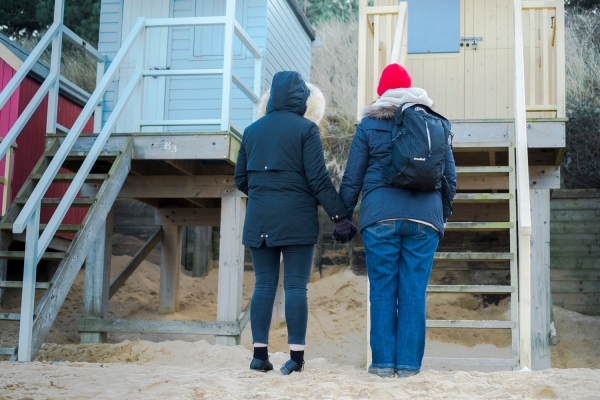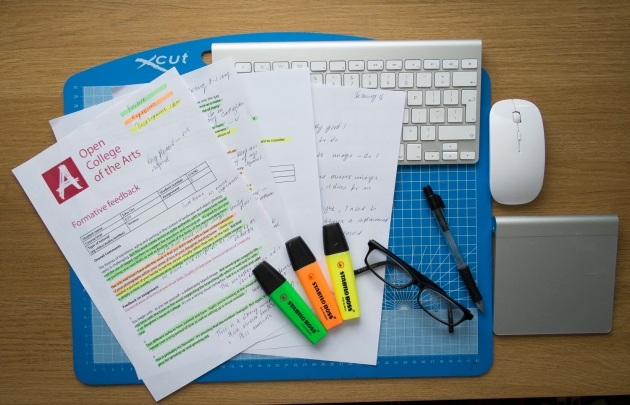“There are two fundamentals in all picture taking – where to stand and when to release the shutter … so photography is very simple.”
(Jay & Hurn, 2001, p.37)
So photography is simply viewpoint and moment… but what about subject? The simplest subject is the moment. You can record the moment with a snapshot, but when you review the photograph later you find you didn’t actually record the moment, you just recorded the ‘event of photography’.
It might take a very long time to simplify the whole world and its infinite framings into a subject that makes sense to you. Robert Adams said, ‘Sooner or later one has to ask of all pictures what kind of life they promote’ (Grundberg, 1999, p.34). For now, though, you should just feel comfortable with your subject. It should say something about you and, in the end, you like it!
Brief
Take a series of 10 photographs of any subject of your own choosing. Each photograph must be a unique view of the same subject; in other words, it must contain some ‘new information’ rather than repeat the information of the previous image. Pay attention to the order of the series; if you’re submitting prints, number them on the back. There should be a clear sense of development through the sequence.
Assignment 5 Submission
Leaving Home – exploring emotion and place
“Landscape pictures can offer us, I think three varieties-geography, autobiography, and metaphor. Geography is, if taken alone, sometimes boring, autobiography is frequently trivial, and metaphor can be dubious. But taken together…. the three kinds of information strengthen each other and reinforce what we all work to keep intact – an affection for life”
Adams (1996)
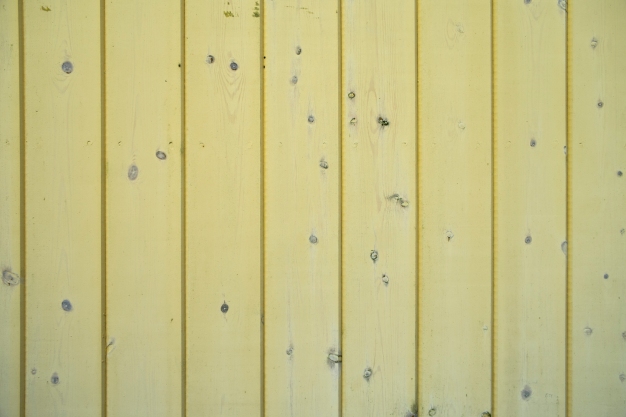

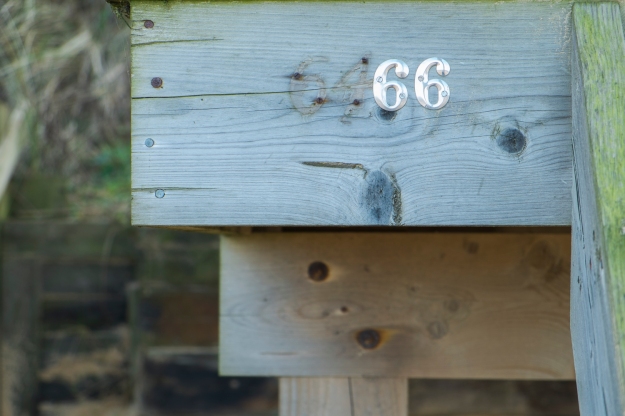





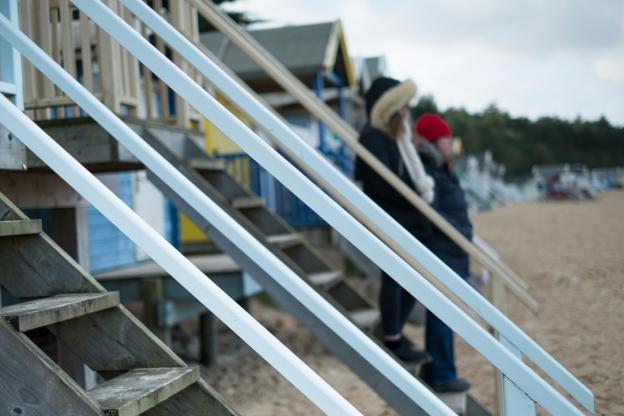

What is it about? – in 300 words
The concept of ‘subject’ is open to interpretation and although the images appear to be of people, places or things, this assignment is an attempt to capture something quite different.
‘Leaving Home’ is response to the fact my daughter is soon to move away to study. This is not an unusual occurrence for families, but it is new for me as a parent. It brings with it a mix of emotions that range from pride in her achievements, to a deep sadness about her departure. For 18 years she has been a central presence in mine and my wife’s life. The sadness and trepidation I feel is in part that she will be across an ocean on another continent in a matter of months. These images were made in a place where we spent much time as a family when our daughter was a young child. Each image contains new information, but this set is not about place, it is a very personal reflection on how I feel about my daughters imminent departure. Whilst the images are anchored in a location they are both biographical and personal, and say as much about the passage of time as they do about a place. The set tries to reflect that there something fleeting about human presence on a beach, not least because each new tide washes away the evidence of what went before. The work uses intentionally stark metaphors to describe the distance between us and the passage of time. The first image is deliberately dull and obscure but as the set progresses, place, time and emotion are revealed. There is also something about relationships that might be drawn from the connotations of a number of signifiers such as the keys, the lock and the steps hinting at my use of place as metaphor for the passage of childhood. The last image is meant to signify decay and the inevitability of all things growing old. All of the signifiers attempt to attest to my ‘original intent’ in this work, my feelings about my daughters transition to the next phase of her life, one in which my wife and I will have a much lesser part.
(333 Words)
How I made this work
Much of Part five of the course has asked students to explore photography as information and I was struck by the importance of the mediums ability to communicate emotion and not simply record a place or time. This for me represents a fundamental shift in thinking about the medium and although perhaps obvious, this last part of the course has brought home to me photography’s power to transcend merely recording things. Of course an image of a person, place or thing can solicit an emotional response in the viewer but this is a simplistic view of the power of the medium. I also reflected for sometime on Alexia Clorinda’s statement in the course materials:
“I don’t pretend that I can describe the ‘other’. The camera for me is more a meter that measures the distance between myself and the other. It’s about the encounter between myself and the other; it’s not about the other.”
The statement clearly suggests that act of making an image is a more complex encounter, with the outcome being a product of an interplay between the photographer and the subject. This was a concept I exploited in this assignment. The final sequence of 10 images were selected from 140 images, which in turn were taken from a much larger group of about 400 images taken over several days. I was very mindful that this was the last assignment of the course and that Part five considered viewpoint, context, information and the photographers intent. I reflected on the writings of Barrett (1997), Barthes (1980) and Bloomfield (2014) as I developed the concepts behind the images and in how I executed the image making, processing and selection. In the final selection I printed some small versions of the images and placed them in different sequences until I hit upon a satisfying resolution to the brief. I treated the activity as if I were making a book and the small prints were a sort of ‘maquette’ for the final submission.
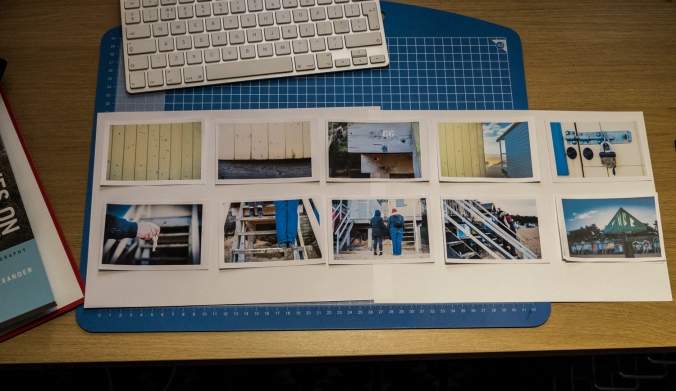
I made a technical shift in execution of this work too. My general preference is to use a wide angle lens for much of my work within the course and my photographic work outside the course. On 35mm equipment I use a 28mm lens and on 6×6 and 645 medium format equipment I often use 45mm and 50mm lenses. For this assignment I used a 50mm standard lens equivalent (35mm) on the crop sensor digital camera used for the assignment. This view is often regarded as approximating the field of view the human eye sees. I also wanted to minimise distortion given the use of straight lines and geometric shapes in the composition of many of the images. This was an important choice in this work because it also meant I had to rethink my distance (literally) from the subjects in all the images.
There is an intentional angular geometry of the man made in many of the images which is intended to contrast with the natural surroundings. For example the straight lines of the shiplap an timber in the first few images contrasted with the naturally patterns of the knots and grain in the timber. In a number of the images the scene is bisected by sharp straight lines. Here the use of the 50mm equivalent lens helped to minimise distortion and meant there was a relatively small amount of post processing of the final images.
Self assessment and reflection
As with all of my work to date I am often left less than satisfied but there comes a point where I have to commit to a final set and move on. I am pleased that I believe there is a sense of narrative to the work and I feel it broadly meets the brief. There is of course scope to develop this work further and I am keen to explore the notion as landscape as autobiography. I was very much inspired by my visit to the Media Space at the Science Museum to see Alex Soth’s ‘Gathered Leaves’. In particular ‘Sleeping by the Mississippi ‘ had quite a profound effect on my thinking about the idea of a road trip, not only in space but in time. Also Soth’s work demonstrates i a wider metaphor for describing a state of being and the associated feelings. This assignment is not an attempt to replicate that work which is very different, but Soth’s use of pictorial elements has influenced this work. I feel I am just that little bit closer to understanding the concept of personal voice, although some way from achieving that aspiration, I have a bit more understanding of the components of personal voice.
Considering the Assessment Criteria
Demonstration of technical and visual skills:
I have sought to produce a series of images that try to capture something of the mixed emotions attached to people, a place and a time. It is not intended to be a sequence about a beach hut or a beach. I think think there is some coherence to the composition of the images and I feel I have managed the technical elements of exposure, focus and composition with a reasonable level of competence. I think there is a sense of visual awareness, particularly in images 4, 5, 9 and 10 where I have used composition and depth of field to convey something of the emotions that have driven this assignment. I set out to capture as much as possible at the point the images were made and all of the final images have had minimal post processing, some ‘locked’ cropping, basic RAW adjustments such as sharpening and white balance refinement. The final images demonstrate competence in the use of camera control and RAW processing techniques. The small print ‘maquette exercise demonstrates an awareness of design and the need for meaning to develop through a linked set of works. I intend developing a more formal approach to using photo book maquettes for exercises in the next module of the course, this is very much an idea in progress!
Quality of Outcome:
There is a clear conceptual underpinning to this work as set out in my 333 word description above. I have used the learning from this section of the course to inform the development of the work and in particular used Barrett’s (1986) concepts of ‘internal context’ and ‘original context’ to create a narrative that I hope says something beyond the pictorial elements of the images about my intention in the work. Although I may not have entirely communicated the ideas that are at the heart of the assignment, I feel this is a good foundation for further exploration of the theme.
Demonstration of Creativity:
This is an imaginative experimental response to the brief, it seeks to capture an emotion, one which in a large part is very personal. I have used a range of signifiers within the work, that perhaps need a stronger set of accompanying text to link them to what I am signifying. In the 4th image for example I have intentionally focussed on the angular construction of the two beach huts of contrasting colours. In the distance the sea and beach are out of focus creating a sense of distance and the unknown. I also wanted the idea of a far horizon and an empty beach to say something about the themes of departure and loneliness. I have taken some risks in this approach and am very conscious of the subjective notion of creativity. Although perhaps pedestrian, this work and the approach I have used has taken me some distance from the type of images I made prior to starting this course. The area of creativity remains for me the biggest challenge in my OCA endeavour because of the illusive nature of what constituents genuinely original work. I recognise this is where I need to focus my energies.
Context:
I think the critical thinking and research skills I have developed throughout the course are an area of strength. I have read much of the recommended reading and the research element of all my assignments to date evidence a rigorous engagement with literature in the field of photography. In this work I have assimilated and accommodated many of themes from Part five of the course, not least the ideas about photography’s power beyond the pictorial. I have begun to touch on some rudimentary concepts within semiotics and I particular the work of Saussure and his notions of signifiers and the signified. A theme I will explore further. In conclusion I have thought critically about the strengths but also the limitations of my work and recognise I still have a some distance to travel!
Submission as sent to tutor in PDF: EYV Assignment 5 Final
Contact Sheets: Assign 5 Contact Sheets
Bibliography
Adams, R. (1996) Quoted (pp 21) in Alexander (2015) Op Cit
Alexander, J. (2015) Perspectives on Place: Theory and Practice in Landscape Photography, Bloomsbury , London
Barthes, R. (1980) Camera Lucida, Random House, London
Barrett, T. (1986) Teaching about Photography: Photographs and Contexts, Art Education July 1986 Vol. 39, No. 4, pp33-36
Barrett, T. (1997) Photographs and Contexts in Goldblatt, D. & Brown, L (Eds) (1997) Op Cit Burgin, V. (1982) Thinking Photography, Macmillan London
Bloomfield, R. (2014) Photography 1, Expressing Your Vision, Open College of the Arts, Barnsley
Burgin, V. (1982) Thinking Photography, Macmillan, London
Clorinda, Alexia (2014) Quoted (pp102) in Bloomfield, R. (2014) Op Cit
Cobley, P & Jansz, L (1998) Introducing Semiotics, Icon Books, London






